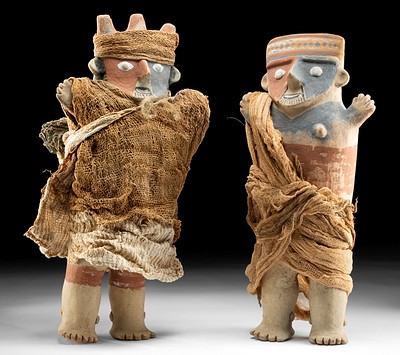11th C. Indian Rajasthan Sandstone Relief of a Jina
Lot 66
About Seller
Artemis Gallery
686 S Taylor Ave, Ste 106
Louisville, CO 80027
United States
Selling antiquities, ancient and ethnographic art online since 1993, Artemis Gallery specializes in Classical Antiquities (Egyptian, Greek, Roman, Near Eastern), Asian, Pre-Columbian, African / Tribal / Oceanographic art. Our extensive inventory includes pottery, stone, metal, wood, glass and textil...Read more
Estimate:
$2,800 - $4,200
Absentee vs Live bid
Two ways to bid:
- Leave a max absentee bid and the platform will bid on your behalf up to your maximum bid during the live auction.
- Bid live during the auction and your bids will be submitted real-time to the auctioneer.
Bid Increments
| Price | Bid Increment |
|---|---|
| $0 | $25 |
| $300 | $50 |
| $1,000 | $100 |
| $2,000 | $250 |
| $5,000 | $500 |
| $10,000 | $1,000 |
| $20,000 | $2,500 |
| $50,000 | $5,000 |
| $100,000 | $10,000 |
| $200,000 | $20,000 |
About Auction
By Artemis Gallery
May 19, 2022
Set Reminder
2022-05-19 10:00:00
2022-05-19 10:00:00
America/New_York
Bidsquare
Bidsquare : Fine Antiquities | Ethnographica | Fine Art
https://www.bidsquare.com/auctions/artemis-gallery/fine-antiquities-ethnographica-fine-art-9350
Featuring a very special collection of Fine Art from the Hollywood Hills, including Picasso & Rookwood ceramics! Also included are many fine examples of classical antiquities, ancient, and ethnographic art from cultures encompassing the globe. Artemis Gallery info@artemisgallery.com
Featuring a very special collection of Fine Art from the Hollywood Hills, including Picasso & Rookwood ceramics! Also included are many fine examples of classical antiquities, ancient, and ethnographic art from cultures encompassing the globe. Artemis Gallery info@artemisgallery.com
- Lot Description
South Asia, India, India, Rajasthan, ca. 11th to 12th century CE. A fabulous sandstone panel, meticulously hand-sculpted with the high relief scene of a Jain Tirthankara or Jina - a savior and spiritual teacher of the dharma - flanked by 2 female attendants. Seated upon a lotus flower in full lotus position, the ancient educator is depicted bare-chested with both hands resting in lap in the dhyana mudra, also known as the meditation mudra. A Srivatsa - one of the 8 auspicious symbols - is shown on his chest in low relief - a traditional iconographic indicator of a Tirthankara. Hair piled in a coiled top bun atop his head, the sacred instructor gazes outward, his serene countenance presenting huge eyes beneath a sweeping brow, a round nose, and a gentle grin. His lengthy ear lobes fall to his square shoulders, symbolizing his renunciation of earthly possessions to immerse fully in the spiritual realm. Size: 10.5" W x 4.5" H (26.7 cm x 11.4 cm); 7" H (17.8 cm) on included custom stand.
Both attendants face their divine teacher, each bowing on 1 knee and holding hands together in a prayer position at their breasts to display the Anjali mudra, expressing honor and respect. The youthful beauties both wear sheer skirts, beaded necklaces that drape their bare chests, and large, annular earrings. Hair neatly pulled back into a low-set chignon, each woman's face showcases, elongated, almond-shaped eyes beneath arched brows, a naturalistic nose, and closed lips. A pair of columns flanks the entirety of the sacred scene.
A Tirthankara, literally meaning "ford-maker" in Sanskrit, is a spiritual teacher, savior, founder of the tirtha, and conqueror of the samsara (cycle of death and rebirth) who made a path for others to follow. According to the Metropolitan Museum of Art, "At the heart of daily Jain religious observance is the veneration of the image of the jina, the conceptual basis of which is the pan-Indian ideal of the yogic ascetic. This ancient practice, celebrated in the Vedas (the most ancient Hindu texts), equates the acquisition of spiritual wisdom with the pursuit of advanced forms of meditation and withdrawal from material comforts. In Jainism, the twenty-four liberated souls who are recognized as having attained this elevated state are worshipped as tirthankaras (ford crossers)."
Provenance: private Hawaii, USA collection, 1995 to 2010; ex-Earl Stendahl collection; ex-Alfred Stendahl collection, acquired 1950s to 1960s; ex-Spinks, London, England, United Kingdom
All items legal to buy/sell under U.S. Statute covering cultural patrimony Code 2600, CHAPTER 14, and are guaranteed to be as described or your money back.
A Certificate of Authenticity will accompany all winning bids.
PLEASE NOTE: Due to recent increases of shipments being seized by Australian & German customs (even for items with pre-UNESCO provenance), we will no longer ship most antiquities and ancient Chinese art to Australia & Germany. For categories of items that are acceptable to ship to Australia or Germany, please contact us directly or work with your local customs brokerage firm.
Display stands not described as included/custom in the item description are for photography purposes only and will not be included with the item upon shipping.
#171699Fragment of a larger piece. Chipping to peripheries. Nicks and abrasions throughout, commensurate with age. Possible resurfacing to faces. Otherwise, excellent with great remaining details and light earthen deposits. Collection label and drill hole on verso.Condition
- Shipping Info
-
All shipping is handled in-house for your convenience. Your invoice from Artemis Gallery will include shipping calculation instructions. If in doubt, please inquire BEFORE bidding for estimated shipping costs for individual items.
-
- Buyer's Premium



 EUR
EUR CAD
CAD AUD
AUD GBP
GBP MXN
MXN HKD
HKD CNY
CNY MYR
MYR SEK
SEK SGD
SGD CHF
CHF THB
THB














